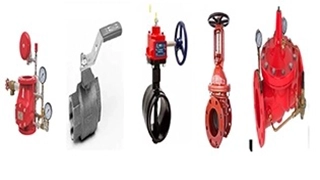Valves are vital components of firefighting water systems, responsible for controlling, regulating, and directing water flow throughout the fire protection network. Whether supplying sprinklers, standpipes, hose reels, or hydrants, these valves ensure **reliable, controlled water delivery** during emergency conditions and support maintenance, isolation, and system monitoring functions.
Common types of firefighting valves include:
* Control Valves – Used to open or shut off water flow for maintenance, zone control, or isolation. These include:
OS&Y (Outside Screw and Yoke) gate valves – Preferred for visible open/closed status. Can be provided with a Supervisory Switch.
NRS (Non-Rising Stem) gate valves – Suitable for below-grade installations
Butterfly valves – Compact, quarter-turn valves often used in large-diameter systems, typically with built-in Supervisory Switches.
Ball valves – Typically used in small-diameter or localized control applications
Check Valves – Prevent backflow to protect the integrity of the system and avoid contamination of the potable water supply.
Alarm Check Valves – Integral to wet sprinkler systems; they allow water to flow upon sprinkler activation while triggering connected alarm devices.
Pressure-Reducing Valves (PRVs) – Regulate high water pressure to safe operating levels, ensuring protection of downstream equipment such as sprinklers, hose racks, and reels—especially in high-rise or high-pressure systems.
Deluge and Pre-Action Valves – Used in special hazard systems to control water release based on external detection signals, such as smoke or heat detectors.
End Connections
Fire protection valves are available with various end connections based on system design and installation requirements:
Flanged connections, typically conforming to ANSI or PN16 standards
Grooved ends for fast, flexible mechanical joint assembly
Threaded ends, commonly used in small-diameter systems or localized controls
Manufactured from ductile iron, bronze, or corrosion-resistant alloys, these valves are built to endure high-pressure operation and harsh environmental conditions. All valve types are designed and certified to meet relevant fire safety standards such as UL, and FM, or EN, ensuring compatibility, durability, and reliable function within active fire protection systems.


